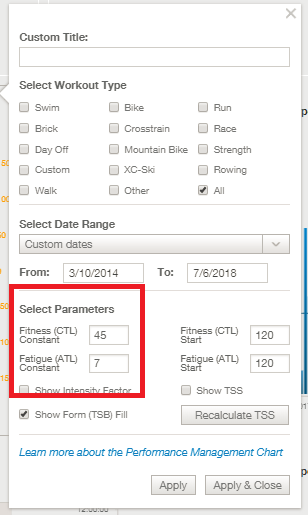Influence Curves:
Individualizing the timing of the load for different athletes
Alan Couzens, M.Sc. (Sports Science)
Orig: Dec 27, 2009. Updated: Jul, 10 2018

"All animals are created equal but some are more equal than others” – The Pigs (Animal Farm).
As the pigs suggest in one of my favorite books, there are situations where while things may appear equal, in reality they are not. One of these situations is in the realm of training load.
Let me explain….
While 300TSS of riding is always 300TSS of riding, the direct impact that this amount of work has on your race performance varies greatly throughout the training year. One of the most practically applicable discoveries that has come from studies that have sought to mathematically model the load-performance relationship (e.g. Banister, 1986, Morton, 1991) is that the contribution that load makes to performance varies with the timing of the load with respect to the key event, i.e. there is a critical period where it is optimal to really ‘lay down’ the big load blocks and there is a quantifiable difference to be had by placing a training camp 4 mths vs 4 weeks before your goal event.
Below you’ll find an example of a typical 'influence curve' that models this difference on the actual performance benefit for a given load depending on how far out from the event the 'dose' of training load is taken.
| τa: | |
| τf |
The chart shows days from goal event along the x axis, with relative performance benefit of a given training load (in arbitrary units) along the y axis. You can change the numbers in the input boxes above the chart to see how they affect the optimal taper length and the optimal period for big load.
The curve shows that there are certain times of the training cycle that a given training load is very beneficial. At other times it is quite detrimental (e.g. during the taper), while at other times of the cycle, e.g. 6 months before the event, the load has very little direct influence on performance in the target event
However, before we get too far into the specific numbers, it is important to note that the shape of the curve varies for different types and levels of athlete.
The modeling studies that I referenced above have sought to pinpoint these specific curves for different athletes by changing the τa and τf constants to come up with a curve that best fits the reality of the athletes' 'real world' performance numbers. Incidentally, these τa and τf constants are the same numbers that are used as the 'Fitness Constant' and 'Fatigue Constant' in Training Peaks Performance Management Chart so you can play around with your own numbers to find the best performance fit for you as an individual athlete.

Overall, the general trend in the research has been that the higher the level of athlete, the higher the τf number is, i.e the longer fatigue stays in the system, the more the athlete will benefit from a longer taper and the further from the event that load is most beneficial. Average values for those values for different levels of athlete from some of those studies are given below
| Category | τa | τf |
|---|---|---|
| Untrained/Recreational (e.g. Busso 1991, 1997) | 49 | 4 |
| Intermediate (e.g. Busso, 1993, Morton, 1990) | 40 | 9 |
| Advanced/National level (e.g. Mujika, 1996) | 41 | 12 |
| International/World Class (e.g. Hellard, 2005) | 50 | 19 |
While the fitness decay constant is in that 40-50 range for the different categories, the tendency is for fatigue to 'hang around longer' for the higher level of athlete. You can play round with the τf number in the chart above to see the effect that number has on the taper length and the optimal timing of the load. Importantly, then, we should plan the timing of overload and taper periods in accordance with the individual specifics of the athlete.
In my own sample of professionals and high level amateurs, the mean τa is 45 and the mean τf is 15 days. On a group basis, this leads to an optimal load emphasis period 30-90 days before the event, i.e. 1-3 months before the key race and an aggressive taper in the last 3 weeks (where the net effect of load on performance is negative). This pattern was also reflected in my optimal periodization' article, which found that putting the hardest load (2560TSS) in months 2 & 3 before the event led to the highest performance among my sample. If my data came from novices we might expect that shortening the taper and putting more of the load closer to the event might have led to a better performance.
In addition to the impact of performance level on τf, other factors also come into play including the gender of the athlete (longer τf for male athletes), the size of the athlete (longer τf for larger athletes), the anaerobic/aerobic balance of the athlete (longer τf for anaerobic athletes) & the nature of the sport, (with lower τf numbers for something low impact like swimming and higher τf's for a high impact activity like running)
Putting the specifics aside, there is a common 3 phase pattern of the impact of load on performance...
Phase 1: Taper/Unload
In the period somewhere between 1 and 4 weeks before the race (depending on the athlete) workouts generally have a pretty marked negative effect on performance, i.e. the freshness that the athlete gets from relative rest gives more to performance than any workout during that time could. Hence the importance of the taper.
Phase 2: The BIG PUSH! (key specific loading period)
Soemwhere between 20 and 60 days prior to the event (depending on athlete specifics) will be the critical period in which load has the greatest effect on performance for most athletes. That loading block from weeks 8->4 is particularly important for most athletes and a big relative performance jump can be exploited with significant loading of specific volume and intensity in this block (a training camp, a couple of big 'simulation' weekends etc). From here to ~100 days before the event, load will tend to have a direct positive effect on the event performance. With a stronger and stronger effect the closer the athlete gets to that critical peak loading period.
Phase 3: Laying the foundation/'Training to Train'
Prior to this, the period of time from weeks 12-26 before the target event can best be termed ‘training to train’. It is a period that, in terms of undertaking heavy training loads, risk greatly exceeds reward. To put in perspective, a 6hr solid ride in this period is worth less than what a moderate 3hr ride would be worth during the critical loading period! Yet undertaking these loads in the early season could significantly compromise the athletes ability to undertake the big loads when they count. This is a very common occurrence among self coached athletes, the so called “February Rock Stars”.
####
While the specifics of these phases may change a little bit depending on the individual peculiarities and training status of the athlete, as mentioned above, the general trends tend to hold.
For most athletes, the most important training will occur in that 4-12 week window before their key event. Any training before this, while not insignificant is merely setting the scene for the ‘real training’ to come.
While perhaps not as well understood, pacing the season is a skill that is just as important as pacing the race. Hopefully by being able to quantify the relative benefit of any ‘hard workout’ in the early season it will enable you, the athlete, to make better decisions with respect to where to distribute your efforts. For, as the pigs allude, not all training efforts are created equal.
Train Smart.
AC
Don't miss a post! Sign up for my mailing list to get notified of all new content....
